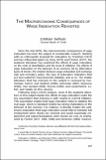The macroeconomic conseguences of wage indexation revisited
| dc.contributor.author | Jadresic, Esteban | |
| dc.date.accessioned | 2019-11-01T00:01:36Z | |
| dc.date.available | 2019-11-01T00:01:36Z | |
| dc.date.issued | 2002 | |
| dc.identifier.isbn | 956-7421-110 | |
| dc.identifier.uri | https://hdl.handle.net/20.500.12580/3633 | |
| dc.description | Since the mid-1970s, the macroeconomic consequences of wage indexation has been the subject of considerable research. Starting with an enthusiastic proposal for indexation by Friedman (1974) and two influential papers by Gray (1976) and Fischer (1977), the academic literature has examined the effects of wage indexation on the costs of disinflation and the level of inflation, the effects of wage indexation on the behavior of an economy hit by alternative types of shocks, the relation between wage indexation and exchange rate and monetary policy, the type of indexation indicators that are best suited for macroeconomic stability, and so on. The sizable literature that has emerged on the subject is reviewed by Carmichael, Fahrer, and Hawkins (1986), Aizenman (1987), Devereux (1994), Van Gompel (1994), Riveros (1996), and Landerretche, Lefort, and Valdés (in this volume). | |
| dc.format | ||
| dc.format.extent | Sección o Parte de un Documento | |
| dc.format.medium | p. 207-257 | |
| dc.language.iso | eng | |
| dc.publisher | Banco Central de Chile | |
| dc.relation.ispartof | Serieson Central Banking, Analysis, and Economic Policies, no. 2 | |
| dc.rights | Attribution-NonCommercial-NoDerivs 3.0 Chile | * |
| dc.rights.uri | http://creativecommons.org/licenses/by-nc-nd/3.0/cl/ | * |
| dc.subject | INFLACIÓN | es_ES |
| dc.subject | TIPO DE CAMBIO | es_ES |
| dc.subject | POLÍTICA MONETARIA | es_ES |
| dc.subject | SALARIOS | es_ES |
| dc.subject | MACROECONOMÍA | es_ES |
| dc.title | The macroeconomic conseguences of wage indexation revisited | |
| dc.type.doc | Artículo | |
| dc.file.name | BCCh-sbc-v02-p207_258 |


